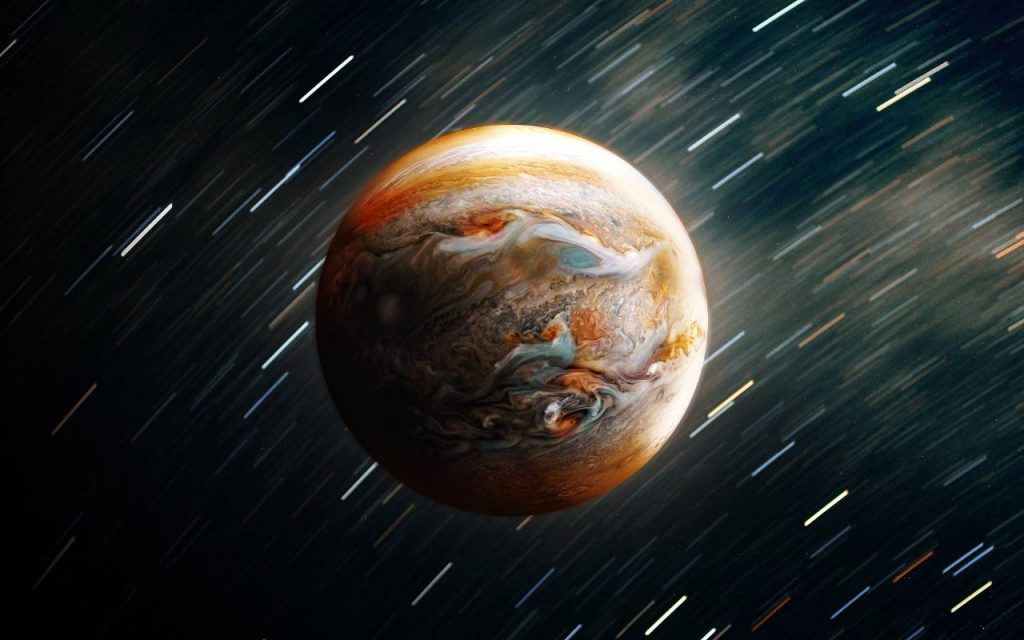On a clear, moonless night, one object shines brighter than anything else in the sky. And it’s not a star – it’s a planet; the gas giant Jupiter.
Next time you look up at night, see if you can spot it. It’s pretty hard to miss, actually.
Despite being an average of 444 million miles away from us, Jupiter is (just) bright enough to cast a shadow on Earth at night. Its huge surface reflects the sun’s light back over that vast distance, its image taking anywhere from 30 to 50 minutes to cross the void into our eyes.
It’s so big, and so massive, that if you added up all the other planets in the solar system, they wouldn’t even count for half of it.
Pretty impressive for a swirling ball of gas.
And speaking of gas, there’s one type of gas that’s of particular interest to us swirling around in those iconic, stripy Jovian clouds – ethylene. And it’s of interest because ethylene gas is the raw material used to create polythene, the plastic packaging solution most widely used on Earth.
You see, the whole point of that solar system-meandering introduction was to point out this simple fact; ethylene is a 100% naturally occurring substance. It’s found in the clouds of Jupiter and Saturn, in the nebulas where new stars are born, and probably in every other part of our universe. We also find it naturally right here on Earth, although not in any significant quantities.
We mostly use ethylene gas for two things; making polythene, and ripening fruit (which we’ll try to explain in more detail…).
But where on Earth does it come from? How is it produced? And will it ever run out?

How is ethylene produced?
Global ethylene production hit 141 million tonnes in 2011, and demand has not slowed. To keep up with our appetite for perfectly ripened fruits and polythene packaging, hundreds of companies over 32 countries are working around the clock to supply the gas. But how are they making it – or are they harvesting it from somewhere?
Well, the answer is kind of both.
Industrially processed ethylene
Ethylene used in polythene packaging is largely produced by the petrochemical industry, from oil and gas harvested from the Earth. A primary method is “steam cracking”, where the naturally occurring hydrocarbons found in natural gas and oil are combined with superhot steam (heated to 950°C), causing the more complex hydrocarbons to break into smaller ones.
When ethane is used as the feedstock, ethylene is the product – but it can also be made from steam cracking naphtha, diesel and from the leftovers of petrol production. It’s separated from the mixture by repeated compression and distillation, to produce unsaturated, pure ethylene gas, which has a naturally sweet and musky smell.
Synthesis
Ethylene gas can be synthesised in a lab by dehydrating ethanol with sulfuric acid. It’s rarely done, as it’s hard to achieve – but it commands a high price. Many scientists are looking for more reliable, cost-effective and high yield ways to synthesise ethylene, to reduce reliance on hydrocarbon feedstocks and reduce CO2 emissions.
Ethylene is also synthesised naturally, from a compound called methionine. This is an essential amino acid found in meat, fish and dairy. We can’t produce this compound ourselves so we have to eat it or supplement our diets with it – and while we humans don’t break it down into ethylene, plants do. It is used as a hormone that controls the life stages of many plants, from germination to the death of flowers. But most crucially, it triggers the ripening of fruit, which is why ethylene gas’s second most prominent use is in the food industry.
So, we need ethylene for more than just making polythene – we need it to feed the world. But how much longer can we keep producing it? Won’t we eventually run out of oil and gas?
Is ethylene gas production sustainable?
If we’re talking in terms of environmental sustainability, then we’re really talking about oil and gas. And these are clearly not going to fall into the sustainable bracket. Also, there’s a lot of energy required to crack ethylene out of harvested hydrocarbons – which adds another environmental burden on top.
However, the process is as efficient as it can possibly be, minimising waste, maximising power usage and repurposing byproducts that would otherwise become direct pollutants. It’s not perfect – but it’s better than the alternative.
We still have to consider how finite these resources are, and their financial sustainability. Oil and gas are dwindling planetary resources, and they will one day become unprofitable to drill for – meaning we’ll have to get our ethylene from somewhere else. And we will of course still need it, at the very least for making food.
This is why there’s a race on to find other ways of producing ethylene gas – from laboratory synthesis, to biosynthesis and natural production methods. Scientists at UCLA even managed to convert CO2 into ethylene, in a process that could one day kill two birds with one stone; reducing greenhouse gas and creating more of the essential chemicals we need to survive.
While this is all great news, it could be years or decades before we get there. And with shrinking resources on Earth, we might soon have to look further afield for the materials and chemicals we so often find ourselves searching for.
Who knows, one day, we could be sending space probes out to harvest ethylene from the clouds of Jupiter, or a far off nebula…
Talk to a polythene expert
Get in touch here, or call us on 01773 820415 to speak with a polythene expert. We’ll help you find a polythene packaging solution that works for you.


